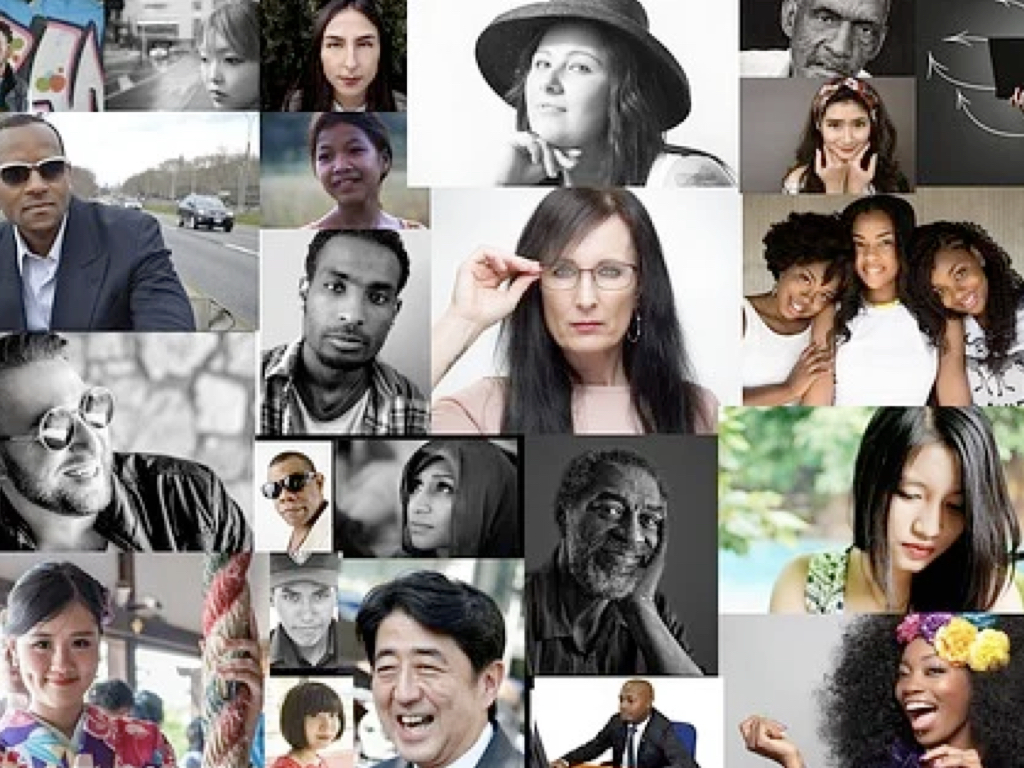
Blog
Finding Your “Blind Spots” – Navigating the Challenges of Unconscious Bias in Today’s Workplace
By Tony Ragoonanan
Are you aware of how you perceive others or how others perceive you?
About 10 years ago, there was a plumbing supplies store that I occasionally visited when I needed an item or two. The owner of the store was usually the only one there but he wasn’t the ideal person to be dealing with and I say this for two main reasons. The first is that he had a habit of speaking very aggressively toward his customers, including me. In fact, I h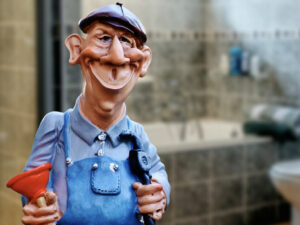 ave had other neighbors who complained about his tone and stopped buying from him as a result. Secondly, he used plumbing terminology that I sometimes couldn’t grasp, and eventually, I had to tell him that I am not a plumber and if he could repeat what he said in simpler terms. At the time, even though I knew that I could have given him some feedback on his approach, he didn’t seem to be the type of person who could take criticism. However, I could have been wrong about that. I never tried, so at that point, the idea that he may not be able to take negative feedback was just an assumption based on his aggressiveness. It was also the nature of my personality back then to avoid conflict, so I felt that I was better off avoiding it and getting my plumbing supplies elsewhere, which is what I did.
ave had other neighbors who complained about his tone and stopped buying from him as a result. Secondly, he used plumbing terminology that I sometimes couldn’t grasp, and eventually, I had to tell him that I am not a plumber and if he could repeat what he said in simpler terms. At the time, even though I knew that I could have given him some feedback on his approach, he didn’t seem to be the type of person who could take criticism. However, I could have been wrong about that. I never tried, so at that point, the idea that he may not be able to take negative feedback was just an assumption based on his aggressiveness. It was also the nature of my personality back then to avoid conflict, so I felt that I was better off avoiding it and getting my plumbing supplies elsewhere, which is what I did.
After about three years, I decided to give him another try, not only because his store was always well-stocked but because the location was very convenient. The experience this time was somewhat different, but not because he had changed (In fact, he was exactly the same). I was now more knowledgeable about plumbing terminology because of the series of plumbing “adventures” I handled myself at home over the years. I had also become more self-aware of my own shortcomings as a communicator. I had my own bias against “aggressive” people as well, which caused me to avoid interactions based on my expectations of what those interactions might look like. It was my own mental shortcut, an assumption. So, what was unconscious before had become conscious and this made change possible.
For the plumber, I realized that all of his behaviours were habits to him. They were unconscious behaviours. He had good intentions and he wanted to help me, but he didn’t realize how aggressive he came across or that the terminology he was using was confusing to others. This is an example of what unconscious bias could look like.
“There are a lot of people who are very sincere in their renunciation of prejudice, yet they are vulnerable to habits of mind. Intentions aren’t good enough.”
– Patricia Devine, Psychology Professor and Director of the Prejudice Lab.
Here is a simple example of how easily we can fall prey to unconscious bias:
Imagine that you bought an older home and began to remodel one of the rooms. However, you noted that one window, which measured two feet horizontally and two feet vertically, let in an inadequate amount of light. Seeking a resolution to this problem, you took your saw and made the opening larger. While admiring your work, noting that a significantly increased amount of sunlight now poured through to brighten the room. However, when you again measured the dimensions of the window you found that it still measured two feet horizontally by two feet vertically.
How can you explain this? (And no, it is not because the sun moved!! The window is actually larger)
See if you could figure it out without reading on (Spoiler ahead).
If you are having a challenge figuring this out, you may be making an assumption here. The assumption that you are making is that it is a square window. The scenario never stated that.
There are many other shapes that could be 2 feet high by 2 feet wide; a circle, a diamond just to name a few. But, I could make a circular window into a square (larger window) and a diamond shape window into a circle (larger window).. and so on.
This may be a meaningless scenario on its own but we make these types of assumptions quite regularly with both situations and people, sometimes on a daily basis. This is what unconscious bias tends to look like in action.
What is Unconscious Bias and How it Affects Our Thinking and Behaviour
“Unconscious bias (or implicit bias) are learned attitudes or stereotypes that exist in our subconscious and can involuntarily affect the way we act and think .”
https://asana.com
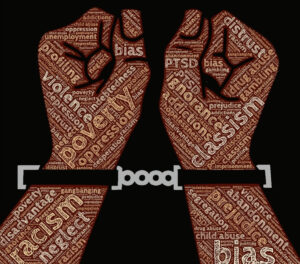 Everyone has unconscious biases. They are the brain’s way of coping with and categorizing all the information we receive. Unconscious biases originate from our experiences and conditioning. Every time we make a decision about situations and people, our social background, life experiences, personal and cultural values have a significant influence on our beliefs, attitudes, and eventual behaviors.
Everyone has unconscious biases. They are the brain’s way of coping with and categorizing all the information we receive. Unconscious biases originate from our experiences and conditioning. Every time we make a decision about situations and people, our social background, life experiences, personal and cultural values have a significant influence on our beliefs, attitudes, and eventual behaviors.
But because our brain has a natural tendency to look for patterns and associations in the world, it will sometimes take shortcuts, causing bad decisions that potentially affect those around us.
“Thinking is difficult, that’s why most people judge.”
– Carl Jung
Conscious bias (or explicit bias) on the other hand is different from unconscious bias, in that, it is to be aware, intentional, and responsive. The person is very clear about his or her feelings and attitudes, and related behaviors are conducted with intent. For example, if you see them dressing up to go to a Klu Klux Klan meeting, it’s more than likely conscious bias.
According to the National Center for Cultural Competence at Georgetown University, “The neuroscience literature tells us that the brain has a unique ability to differentiate between those who are ‘like us’ or ‘in-group’ from those who are ‘not like us’ or ‘out-group’…… The mere fact that the person is coded as ‘not like us’ or implicit stereotyping results in differential treatment, with those ‘like us’ being treated better. In addition, the mirror neurons (those neurons that enable us to have experiential insight into others or have empathy) are not activated the greater the bias is. Implicit bias then can be a function of our brains automatically assigning a person to a group whom we have coded as “other.” Therefore, we have less interest and empathy for that person.”
The literature also went on to say that the brain will sometimes interpret the “not like us” as a survival mechanism, therefore, it will determine if the situation is threatening or non-threatening. It will sometimes link fear with “not like us.” Fear correlates with the activation of the amygdala (the emotional center of the brain), which has a major role in the “freeze, fight or flight” response. This becomes activated within milliseconds causing a reaction before the logical part of the brain is engaged. It is the reason we act on impulse, unconsciously, and sometimes regret it later on. The message this sends us is that we must learn to manage our emotions as a start but there is more that will support this (as we will see later on).
Types of Unconscious Bias
For this section and to give additional support to this topic, I have taken the following excerpt from my previous blog:
The Link Between Behaviour and Culture We NEED To Talk About
“There are many types of unconscious bias and here are just some of the categories (with examples) that they will fall into:
Anchoring bias – Being overly influenced by the first piece of information we receive. For example, we may hear something about someone on the team from a colleague that may or may not be true and tend to believe it. In some cases, it may be because of the relationship we have with the person who told us.
Confirmation bias
– Placing more value on information that supports our existing beliefs. This leads us to reject any information that opposes our beliefs. For example, a person has called or texted someone, only to receive no reply. This person, because of having low self-esteem, uses confirmation bias to assume that the person must dislike them.
Conformity Bias – Conformity bias is the tendency of people to act similarly to the people around them regardless of their own beliefs — also known as peer pressure. For example, we may tend to go along with a decision or behaviour because the rest of the team agrees with it or is demonstrating it.
Affinity Bias – Affinity bias occurs when you unconsciously prefer someone because they remind you of yourself or people you know and like. For example, we may show unconscious favoritism to someone who reminds us of a good friend.
These are just some of the biases that exist and can hurt the organizational environment, in that, any feeling of fairness by employees could be drastically affected and have a disastrous effect on levels of trust, overall relationships and results.”
How the Pandemic Has Impacted Unconscious Bias
Is unconscious bias more pronounced for those who are working from home or in any type of hybrid environment?
It could be both. For those of us who are working in any type of hybrid environment, i.e some employees are at home, some at the office, and some doing both, unconscious bias, in a lot of cases, is more pronounced because people are seeing each other less, at least less in terms of the face to face collaborations and spontaneous interaction s that allow small talk and connection. With a Zoom meeting, for example, we have our meeting and we get off so in this case, because of the limited time, we allow ourselves to be more susceptible to bias. Also, leaders are more likely to make snap judgments that lack objectivity. For example, how can they consistently assess the performance of individuals in a remote workplace where they can’t always observe behavior. Maybe insecure leaders are assuming that their employees are not working because they are at home.
s that allow small talk and connection. With a Zoom meeting, for example, we have our meeting and we get off so in this case, because of the limited time, we allow ourselves to be more susceptible to bias. Also, leaders are more likely to make snap judgments that lack objectivity. For example, how can they consistently assess the performance of individuals in a remote workplace where they can’t always observe behavior. Maybe insecure leaders are assuming that their employees are not working because they are at home.
On the other hand, as we move closer to digital fluency, both leaders, as well as their direct reports, will find ways to improve connection and online collaboration. This will open the door to making biases less pronounced, simply because people will find ways to communicate more regularly, improve trust and make teamwork more effective. There are people who are there already because the digital transformation in their case has been extremely fast.
So it can go either way. It really depends on the action you take and the organizational support you have to address the challenges that apply to your situation.
3 Ways to Address Unconscious Biases at Work
Many approaches have been used to address the issue of unconscious bias, but the solution is not clear-cut. Each type of bias requires a completely different type of solution. It’s really up to an individual to become aware of what their bias is and with organizational or leadership support, take the necessary action to deal with it.
The one thing we have control over, however, is what we do, not what we think, at least not all the time. Thoughts come into our minds at random sometimes. We don’t know what will enter our minds in the next 2 seconds or 2 minutes. This is the problem with unconscious bias. However, we can choose to more closely mentally examine how and why we are thinking what we are thinking. This will help to control how we perceive situations and people. Studies have shown that even though we may not be able to eliminate our unconscious biases, we can at least make shifts in our behaviour.
There is a popular analogy about a frog in water that shows the importance of making a choice to change:
It is said that if you throw a frog into boiling water, the frog will immediately jump out. But, if you put a frog into cold water that is slowly heating up, it will stay there and die.
This is what happens to many of us; we stay in environments or with habits (thinking habits included) that continuously hurt us and could be detrimental in the long run. We have the choice, however, to look at what is harming us and use objectivity to change our perceptions as well as our behaviours and emotions.
Making a change means examining not only how we think but how we think about the way we think.
Here are 3 key ways to address unconscious bias in the workplace that could make the difference:
1. Recognize how experiences have shaped your perspectives and that of others

There is a great “snow globe” analogy that author Peter A. Levine used in his book “Trauma-Proofing Your Kids: A Parents’ Guide for Instilling Confidence, Joy and Resilience” to illustrate how past trauma still affects us today. But, I am going to use it a bit differently. I am using a “shaken” snow globe to represent negative beliefs, attitudes, and behaviors that our social background, life experiences, personal and cultural values have created. In order for the “snow” to settle, it must stay still. That stillness and process of settling represent the analysis that we must do to understand the reasons for our beliefs, attitudes, and eventual behavior toward individuals and groups. This is a choice!!!
With regard to others, we have a tendency to give people labels when we find them “difficult.” There is no solution for the problem if you are giving a label. There is no solution to calling a colleague a “fool,” an “idiot,” or something worse. The better option is to analyze why this person may be acting or reacting that way. For many, the “snow” in their “mental snow globe” has not settled because of an incomplete process. An incomplete process is simply something that the person may not have worked through. This is the reason that they will continue their behaviour. Just like you have a perspective on things, they would also. The situation calls for interaction.
Having regular conversations and other interactive activities to clear perceptions is usually the best way forward. But, this is not as easy as it sounds because unconscious biases are deeply ingrained into our thinking. However, ongoing interactions between individuals as well as groups can do wonders to clear up biases over time. The other variable that can determine how effective these interactions can be, is all about adapting to the differences that we have with others.
2. Be aware of the “environment” you create (Why our differences matter)
In 1936, Psychologist Kurt Lewin published the equation: B = f(P E), which states that behavior (B) is a function (f) of the person (P) in their environment (E). This is still valid today. We all create an “environment” around us. More often than not, it dictates how people behave toward us. For example, if you are a very autocratic or aggressive leader who demands perfection, your employees may be fearful or at least uncomfortable approaching you if they have an issue or problem. I discuss this and its implications in more detail in the next section on developing trust.
Are you aware of your personality type or how you “show up?”
Here is a brief explanation of just one model for the four personality types that have evolved from the earlier concepts:
Driver: the person who moves very quickly to action, takes charge, and wants solutions;
Analytical: the person who sets high standards and values accuracy and details. They are orderly and organized;
Expressive: the person who likes to be included in everything. They thrive on excitement and loves to be around other people;
Amiable: the person who is patient and well-balanced, is warm and friendly, and wants everyone to get along and be happy.
What usually happens is that people will adjust their behaviour based on the “environment” you are creating according to your personality. If you, for example, are a Driver, an Amiable person may hesitate to come to you with questions or concerns based on both their nature as well as your autocratic nature. Interactions may be delayed, information may not be received, and so on. This is the reason we need to step back and analyze how we may be “showing up” to others and have the level of vulnerability to see why we may be having the type of interactions we have.
Before proceeding, there are two very significant points to make. The first is that we all have these four personality types within us. It’s just that one is dominant under normal circumstances. It is how you “show up” to others. The fact that they are all within us is the reason that makes adapting possible. Secondly, no personality type is better than the other, it just depends on the situation you are in.
3. Develop trust
Trust is critical in the workplace. Adapting to the personality types is just one way to develop trust between one another and when trust increases, unconscious biases decrease. Trust is the key to establishing better relations between team members in the workplace. The concept by Patrick Lencioni in his book: “The Five Dysfunctions of a Team: A Leadership Fable“ is illustrated extremely well. Please refer to Figure 1 as you read the following:
Absence of Tr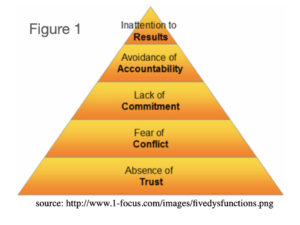 ust is placed at the bottom as trust is the foundation of any team. If members of a team don’t trust one another, it’s almost impossible for them to achieve their goals. This absence of trust stems from the inability or unwillingness to be vulnerable. Vulnerability, according to the dictionary definition; “capable of being physically or emotionally wounded” (Merriam-webster.com) but it is slightly nuanced in this case. Daniel Coyle, the author of “The Culture Code”, says the four most important words a leader can say are, “I screwed that up.” Yes, this may open a person up to criticism, some negative feedback, and being “wounded”, but it is not a weakness. It actually opens the door to improvement because team members feel more comfortable being open and honest in sharing their feelings, concerns, and questions with you.
ust is placed at the bottom as trust is the foundation of any team. If members of a team don’t trust one another, it’s almost impossible for them to achieve their goals. This absence of trust stems from the inability or unwillingness to be vulnerable. Vulnerability, according to the dictionary definition; “capable of being physically or emotionally wounded” (Merriam-webster.com) but it is slightly nuanced in this case. Daniel Coyle, the author of “The Culture Code”, says the four most important words a leader can say are, “I screwed that up.” Yes, this may open a person up to criticism, some negative feedback, and being “wounded”, but it is not a weakness. It actually opens the door to improvement because team members feel more comfortable being open and honest in sharing their feelings, concerns, and questions with you.
For example; do you know the challenges that “show up” with your personality type?
Without trust, a team cannot hope to have constructive and helpful dialogue. There will be Fear of Conflict. This will create artificial harmony. For example, a leader may think that everything is ok in a meeting because no one expressed concern or had questions, but if the leader is not being approachable and open to feedback, colleagues will not trust them enough to talk open up during that meeting.
A lack of healthy conflict from the previous dysfunction creates an environment where team members are unable to buy into the decision-making process. This creates a Lack of Commitment. without feeling comfortable expressing their opinions about a decision, they’re unlikely to feel passionate or committed to the results of that decision. The result is uncertainty and vagueness throughout the organization.
This causes an Avoidance of Accountability because It becomes difficult to criticize a peer and hold each other accountable for behavior, effort, and performance. This creates an atmosphere of low standards
This leads to Inattention to Results. Ego and personal status get in the way of collective success. But this entire process starts with TRUST.
“If we don’t trust one another, then we aren’t going to engage in open, constructive, ideological conflict.”
– Patrick Lencioni, The Five Dysfunctions of a Team: A Leadership Fable
Trust begins to open the door to psychological safety which is an environment where individuals feel that they can speak up, offer ideas, and ask questions without fear of being ridiculed by members of their team. Issues can then be discussed freely and unconscious biases can be minimized.
Conclusion
The focus for us, as well as the organizations we represent, must be on people. Sometimes the focus is so much on processes that we lose sight of the value of people and what they bring to the concept of diversity. As for us, being more self-aware and having conversations with our colleagues can reduce unconscious bias, whether we are in-person or virtual. So again, we have to make both personal and organizational adjustments when necessary. In the end, it all comes down to the fact that our organizations and society as a whole is depending on us to make the right decisions based on the right information.
If you found this blog useful, please leave your comments and feel free to share with your colleagues.
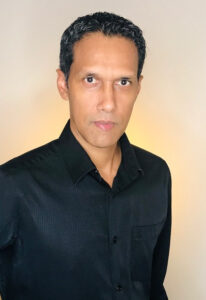 Tony Ragoonanan is the Founder of V-Formation Training & Development. As a Trainer and Performance Management Specialist, he helps individuals, teams, and businesses to align behaviours and goals, create the right organizational culture, and maximize capability. Outside of this, Tony is currently minding his own business focusing on family, football, and fitness!!
Tony Ragoonanan is the Founder of V-Formation Training & Development. As a Trainer and Performance Management Specialist, he helps individuals, teams, and businesses to align behaviours and goals, create the right organizational culture, and maximize capability. Outside of this, Tony is currently minding his own business focusing on family, football, and fitness!!
868-681-3492 | tonyr0909@gmail.com
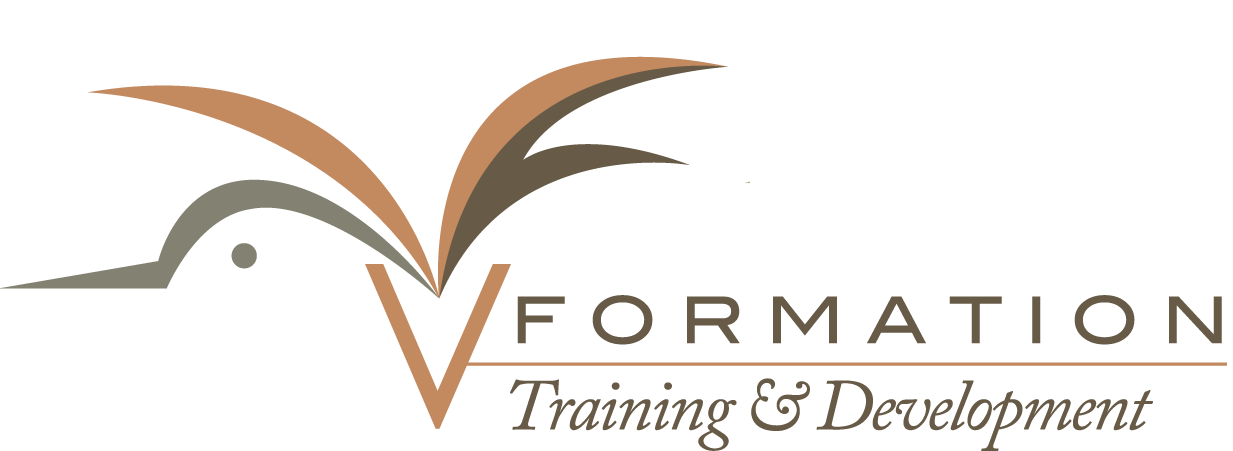

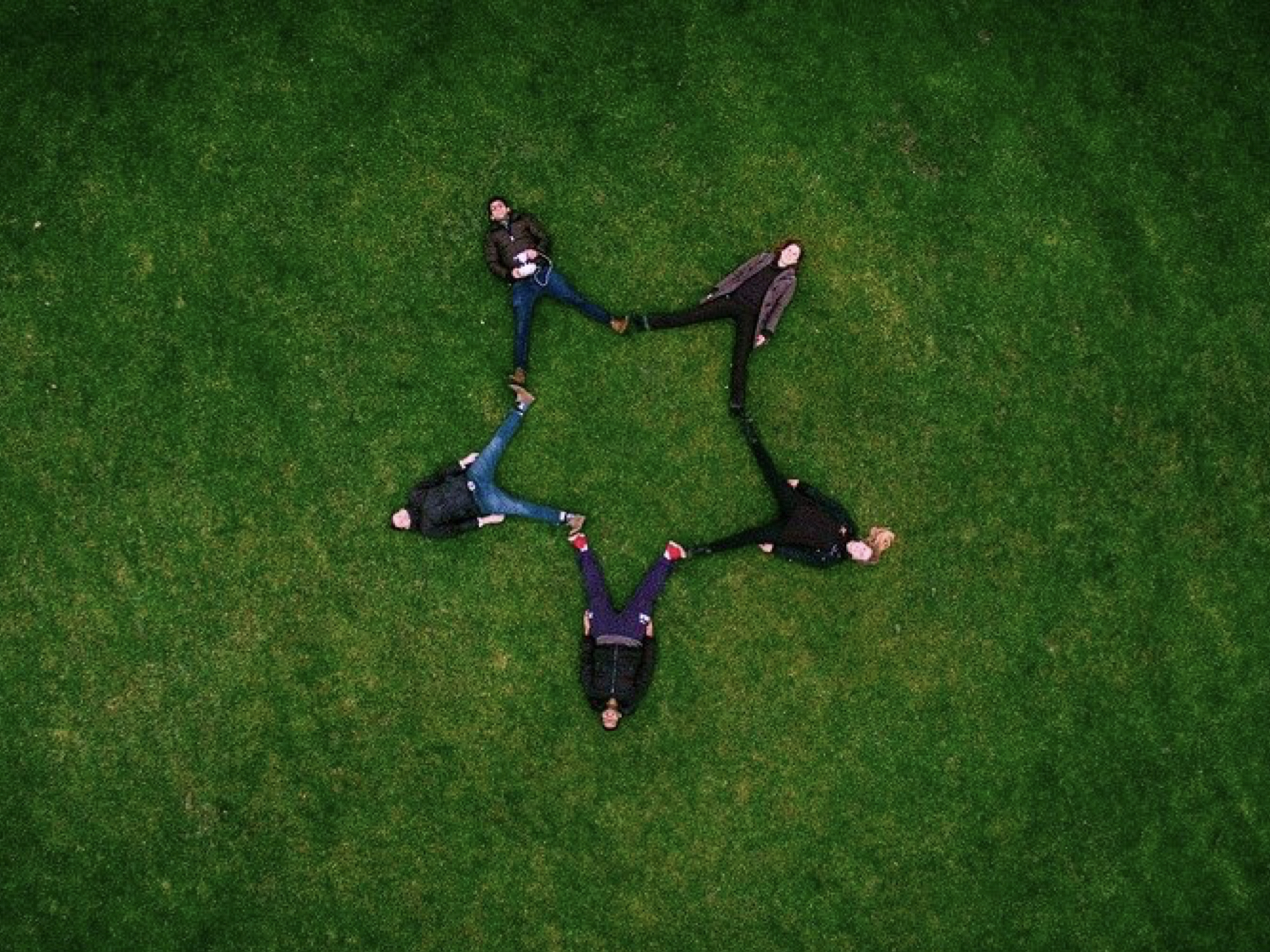

Leave a reply